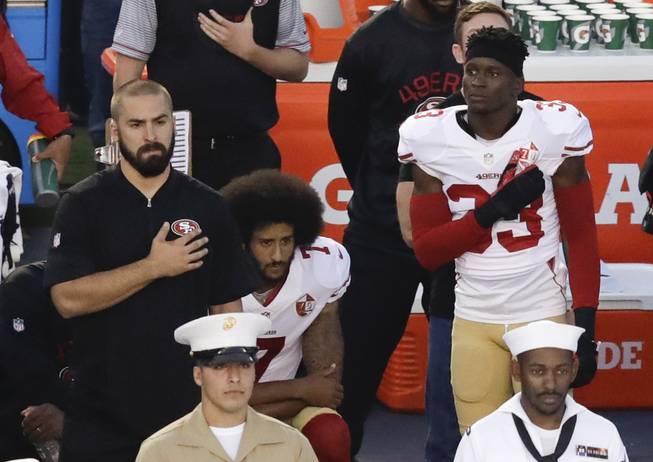
Chris Carlson / Associated Press
San Francisco 49ers quarterback Colin Kaepernick, middle, kneels during the national anthem before the team’s NFL preseason football game against the San Diego Chargers, Thursday, Sept. 1, 2016, in San Diego.
Saturday, Sept. 3, 2016 | 2 a.m.
The continuing refusal by San Francisco 49ers quarterback Colin Kaepernick to stand during the playing of “The Star-Spangled Banner” before games has set off a debate about patriotism, protest and professional sports. But it has also raised another fraught question: Is our national anthem itself racist?
The journalist Jon Schwarz, writing in The Intercept, argued yes, denouncing the lyrics, written by Francis Scott Key during the War of 1812, as “a celebration of slavery.” How could black players, Schwarz asked, be expected to stand for a song whose rarely sung third stanza — which includes the lines “No refuge could save the hireling and slave/From the terror of flight or the gloom of the grave” — “literally celebrates the murder of African-Americans”?
That argument drew outrage from some conservative news outlets, as well as a more scholarly rebuttal from Mark Clague, a musicologist at the University of Michigan and the founding board chairman of the Star Spangled Music Foundation. We spoke with Clague, who is writing a book about the song, about the anthem’s history and shifting meanings. The interview has been edited for clarity and length.
Q. Why do you think those who call the song racist are wrong?
A: The social context of the song comes from the age of slavery, but the song itself isn’t about slavery, and it doesn’t treat whites differently from blacks. The reference to slaves is about the use, and in some sense the manipulation, of black Americans to fight for the British, with the promise of freedom. The American forces included African-Americans as well as whites. The term “freemen,” whose heroism is celebrated in the fourth stanza, would have encompassed both.
Few people know “The Star-Spangled Banner” has a third verse, since it was often left out of 20th-century sheet music publications. Why?
I don’t think people were afraid of offending African-Americans, but of offending the British. It was their blood that “has wash’d out their foul footstep’s pollution,” as the third verse puts it. But when we became allies in World War I, we really started reversing course.
Part of the difficulty of parsing the anthem seems to that Americans know so little about the War of 1812. Why is public understanding so murky?
It’s something in our history we would probably rather skip over. Nobody won, nobody lost. The British burned down the White House. We invaded Canada. It was sort of a bizarre war. But while it didn’t really change much, it was pivotal as far as American identity went. The naval buildup really created the modern American national state. That’s part of the reason why “The Star-Spangled Banner” seems so natural and true and permanent and sacred to us today. It didn’t really describe America in 1814, when Key wrote his lyrics, but it was a vision of the unified power the country would become.
For your project “Poets & Patriots,” you tracked down around 100 sets of lyrics written by others. How do these alternate versions help us understand the meaning of the song?
There are versions that talk about temperance, about women’s suffrage, about presidential campaigns, including Abraham Lincoln’s. The one I wish everyone knew about was one about abolition from 1844, beginning “Oh say, do you hear ...” It repeats Key’s phrase “the land of the free” but as an ironic statement. I wish teachers would contrast that version with Key’s, as a way of showing how singing the anthem isn’t a mindless, rote ritual, but part of a long history of exploration of what the country is about.
Does that same kind of revision go on today?
By the 20th century, we were treating the anthem as a religious hymn, and it became counterproductive to alter the lyrics as social commentary since changes to the anthem tend to make people so upset. In the 20th century, commentary became less about the lyrics than about the performance. Take Jimi Hendrix’s version. It was a combination of patriotism and protest. Here you have an African-American man, speaking largely to white youth but really to all youth, about their own potential to create the country at a moment when they were old enough to be drafted, but not necessarily old enough to vote.
What do you see as the most important part of the anthem?
For me, it’s the punctuation that ends the part we sing. After “land of the free,” we have a question mark, not an exclamation point. Is the flag and what it represents still there? Are we winning the battle for freedom that this country was founded on? That’s where Colin Kaepernick has started a productive conversation. If there are people who don’t feel the song represents them, we need to pay attention to that. But if we just reject the song as racist, or declare that it isn’t our anthem anymore, we don’t fix the problem.

Join the Discussion:
Check this out for a full explanation of our conversion to the LiveFyre commenting system and instructions on how to sign up for an account.
Full comments policy